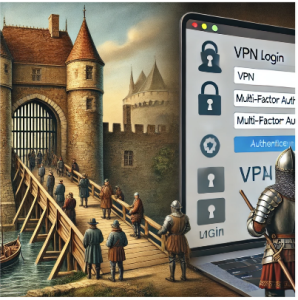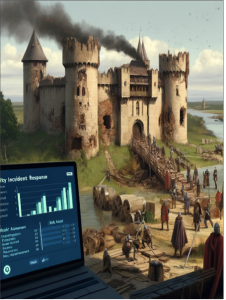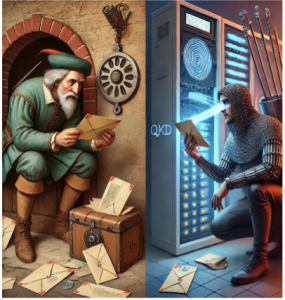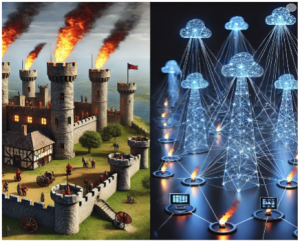Fortresses of Old and New: From Medieval Castle Sieges to Modern-Day Cyber Attacks


Stephen Hudson
CEO @ BlockAPT
Is cybersecurity as complex as it seems?
As CEO of BlockAPT, I have often found that cybersecurity is perceived as overwhelmingly complex. The sheer volume of tools, terminology, and evolving threats can make it seem impenetrable to those who aren’t technical experts. However, after a year of listening, learning, and analysing, I’ve realised that cybersecurity, at its core, is not a new concept—it is simply an enhanced, more intricate version of defence tactics that have existed for centuries.
Throughout history, castles and fortresses protected nations, rulers, and wealth from invaders. Their walls, moats, and soldiers served the same role that firewalls, endpoint protection, and AI-driven security do today. Governments, enterprises, and critical infrastructure are the castles of the modern world, targeted by adversaries looking to breach their walls, steal their data, or cause disruption.
I wanted to write this blog to simplify cybersecurity by showing its direct parallels with the past. Often, cybersecurity platforms – just like BlockAPT – appear complex at first glance. However, much like castle defences, our platform integrates multiple security layers into a seamless, self-defending autonomous system. If castles evolved to withstand stronger siege tactics, then cybersecurity must evolve to counter AI-driven threats and quantum-powered cyber-attacks.
Much like autonomous cars are transforming driving, BlockAPT is an autonomous self-defending platform that will transform cybersecurity. However, for now let’s explore how the past and present are more connected than they seem.
The Multi-Layered Defence: Castles and Cybersecurity
Throughout history, towering fortresses stood as bastions against invading forces, their imposing structures embodying strength and strategic brilliance. These medieval castles, with their layered defences and vigilant sentinels, find their modern counterparts in today’s cybersecurity frameworks.
Just as castles relied on multiple defensive layers—from outer walls and moats to inner keeps and strongholds—modern cybersecurity follows a layered approach, ensuring that threats must overcome multiple obstacles before reaching critical assets. Both medieval and modern security systems operate under the same fundamental principle: even if one line of defence is breached, deeper protections remain intact in a defence-in-depth approach.
This concept is the foundation of modern cybersecurity strategy, commonly known as the Seven Layers of Defence – a model designed to fortify digital assets much like castles once protected their rulers, treasures, and citizens.
Layer 1: Perimeter Defence – The Outer Walls and Moats
In medieval times, outer walls, moats, and fortified gates were the first line of defence. Attackers had to cross treacherous terrain, face arrow fire from archers, and withstand counterattacks before even reaching the main gates.
Attackers’ Strategy:
- They would probe the walls for weaknesses, looking for cracks or poorly defended sections.
- Siege engines like battering rams or trebuchets would be used to apply brute force.
- If unsuccessful, they might attempt to dig tunnels under the walls or send spies disguised as traders to bypass the gate.
Defenders’ Response:
- Firewalls and Intrusion Detection Systems (IDS/IPS) serve as modern-day walls, monitoring incoming traffic and blocking suspicious activity.
- Automated security tools detect and neutralise threats before they reach critical systems.
- Early warning systems (threat intelligence) alert defenders of unusual activity, allowing pre-emptive action.
Layer 2: Secure Network Access – Guarded Gates and Drawbridges
No castle could remain fully isolated. Trade, alliances, and diplomatic missions required controlled access points, like gates and drawbridges. However, these openings also represented vulnerabilities.

Attackers’ Strategy:
- Spies might attempt to bribe gatekeepers or disguise themselves as friendly merchants.
- A stealth team might sneak in during a shift change when guards are distracted.
- They may use deception, posing as messengers with fake credentials to gain access.
Defenders’ Response:
- Multi-Factor Authentication (MFA) ensures that only trusted individuals enter.
- VPNs and Zero Trust models continuously verify identity rather than assuming all inside are safe.
- Access Control Lists (ACLs) restrict movement, ensuring even insiders cannot go where they shouldn’t.
Layer 3: Endpoint Security – Watchmen and Scouts
Castles relied on scouts and watchmen to monitor potential threats in the distance, raising the alarm before attackers reached the gates.
Attackers’ Strategy:
- They might observe the castle over months, taking note of guard patrols.
- They could send small raiding parties to test defences and find weak spots.
Defenders’ Response:
- Endpoint Detection and Response (EDR) solutions act as scouts, continuously scanning for malicious activity on devices.
- Regular patching ensures vulnerabilities are fixed before attackers exploit them.
- Security alerts act like war horns, notifying defenders of impending threats.
Layer 4: Application Security – Inner Barricades and Traps
If invaders breached the outer defences, castles had inner barricades, reinforced doors, and even hidden traps to slow them down.
In cybersecurity, application security serves the same function, using secure coding practices, penetration testing, and API security to prevent attackers from exploiting vulnerabilities inside software and cloud applications.
Layer 5: Data Security – The King’s Treasury and Vaults
The ultimate goal for invaders in the past was often the castle’s treasury, where gold, artifacts, and royal possessions were kept under the strongest protection.
In cybersecurity, data encryption, access controls, and Zero Trust policies ensure that even if attackers bypass multiple defences, they cannot access critical information.
Layer 6: Security Monitoring – The Generals and Commanders
Castles relied on war strategists and generals who analysed incoming intelligence and prepared the best defensive tactics.
In cybersecurity, SIEM (Security Information and Event Management) and SOAR (Security Orchestration, Automation, and Response) play this role—collecting threat intelligence, analysing attack patterns, and automating responses.
Layer 7: Security Awareness & Training – The Soldiers and Citizens
A castle’s strength was not just in its walls but in the people defending it. If soldiers were untrained or citizens were unaware of enemy tactics, the castle would fall.
In cybersecurity, human error remains the biggest vulnerability. Social engineering, phishing, and weak passwords can undermine even the most advanced security tools. This is why continuous security awareness training is critical.
The Aftermath: Post-Attack Recovery
No defence is perfect, and every attack—successful or not—leads to reflection.

Possible Outcomes:
- Successful defence: Defenders analyse strengths and identify improvements.
- If breached, assessing the damage:
- Were they held to ransom? Just like hostages, ransomware locks critical data.
- What needs rebuilding? Damaged castle walls meant expensive repairs; cyber breaches require new tools, stronger defences, and budget reallocations.
- Citizens’ (Clients’) reactions:
- Did they stay loyal or leave due to a breach?
- Did others help rebuild, knowing stronger defences would emerge?
This mirrors today’s cybersecurity landscape. A strong response to a breach enhances customer trust, while weak handling can lead to reputation damage and loss of business.
The Next Evolution: Cybersecurity Mesh and Quantum Security
Just as castles evolved their fortifications to withstand new siege tactics, cybersecurity must evolve beyond traditional defences to counter modern threats.
Cybersecurity Mesh Architecture (CSMA): A Unified Defence Strategy
Gartner introduced Cybersecurity Mesh Architecture (CSMA) as the future of security, recognising that isolated security tools create gaps. In medieval times, a castle’s defences were only as strong as their weakest point—a single unguarded gate or overlooked tunnel could lead to disaster.
Why CSMA Matters:
- CSMA connects and integrates security tools across multiple environments (cloud, on-premises, remote networks).
- Threat intelligence is shared instantly across all layers, allowing defences to adapt dynamically to new attacks.
- Security automation and AI-driven responses ensure threats are contained in real time—eliminating manual delays. Just as medieval rulers ensured every part of their castle was fortified, CSMA creates a seamless, adaptive security strategy for the digital era.
Quantum Cryptography: The Future of Secure Communication
Even the strongest castles fell when attackers developed superior weapons. The same is happening in cybersecurity—quantum computing is advancing, and traditional encryption will soon be vulnerable.

How Quantum Cryptography enhances defence:
- Quantum Key Distribution (QKD) ensures intercepted communications immediately become unusable to attackers.
- Post-Quantum Encryption protects data at-rest and in-motion, ensuring stolen data remains unreadable.
- Strategic partnerships enable cutting-edge cryptographic protection.
Organisations must now adopt Quantum Cryptography and Cybersecurity Mesh to defend against the cyber warfare of tomorrow.
BlockAPT: The Future of Cyber Defence
I firmly believe BlockAPT is the next leader in cybersecurity. Just as medieval rulers strengthened their fortresses, organisations today must enhance their cyber defences.
BlockAPT is designed to be:
✅ Autonomous – A self-defending autonomous platform, leveraging AI-driven automation to detect, respond, and neutralise threats in real-time.
✅ Integrated – Provides a Cybersecurity Mesh Architecture (CSMA) that eliminates security silos and ensures seamless security operations.
✅ Quantum-Resistant – Through strategic partnerships with Quantum Security providers, BlockAPT ensures that even the most sophisticated cyber threats are contained and mitigated.
The cyber battlefield is evolving, and those who fail to modernise will fall, just as ancient fortresses eventually crumbled when they didn’t adapt. BlockAPT is at the forefront of this transformation, providing governments and enterprises with a platform to defend against the cyber threats of tomorrow.
Final Thoughts: The Future is Now
History has shown defences must evolve to stay ahead of attackers. BlockAPT is leading this transformation, ensuring businesses, enterprises, and governments are not just protected but prepared for the threats of tomorrow.

The cyber war is here—are you ready to defend your castle? 🚀